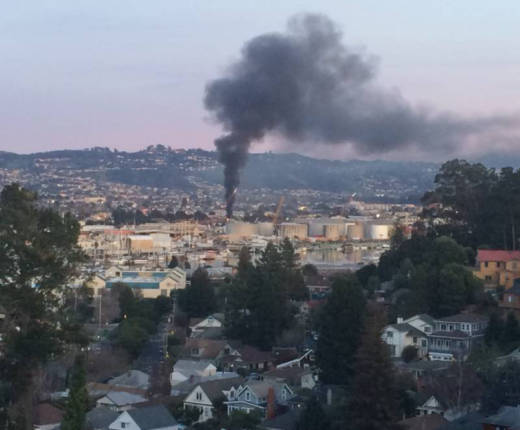“I went into the center of this pile,” Govan said. “Everything was burned.”
So much of the material was charred it was impossible to find out what heat source led the debris to catch fire, Govan said.
In the coming weeks the department plans to issue an investigative report that could include a set of recommendations aimed at preventing another large blaze at the facility.
Fire Reveals Weaknesses in Emergency Communication
The fire prompted a set of alerts ordering residents to stay indoors. In the days after the fire, residents and the city’s mayor, Tom Butt, a longtime critic of Contra Costa County’s community warning system, complained that the shelter-in-place alerts were too slow and confusing.
There was a 40-minute lag between the time Richmond fire officials asked the county to initiate a community alert and the time it was issued. That lapse prompted a meeting on Feb. 8 between Richmond city officials and the Contra Costa County Sheriff’s Office.
During that discussion county officials emphasized that not just any member of the Fire Department could initiate an alert request — that only an “incident commander” could do so. During the next emergency, Richmond Fire Chief Adrian Sheppard says his department will follow those rules.
Other weaknesses in the emergency response came up in that meeting: Unlike other local cities, Richmond does not use Nixle, the free online service utilized by local governments around the country to help warn their residents of emergencies. And if a Spanish-speaking resident wants to sign up to receive one of the county alerts, they must navigate through a set of prompts in English.
The Contra Costa County Sheriff’s Office would not respond to request for comment on the warning system other than to refer back to a statement issued in response to Mayor Butt’s criticism, defending the program.
Residents also wanted to know why the alert system did not use the sirens the county regularly tests. Sheppard later revealed that fire officials were concerned the sound of the sirens would prompt people to flee their homes when the department wanted them inside because of the smoke.
The fire has prompted Richmond to consider placing Sims under the same regulations the city uses to oversee the Chevron refinery. The City Council voted last week to look into expanding its industrial safety ordinance to cover the facility as the city reviews whether Sims is complying with rules governing its work near the Port of Richmond.
At that council hearing, Sheppard acknowledged weaknesses in the city’s inspection system after revealing that Sims had not been inspected in several years.
Sheppard told the council he believes the last time the facility was inspected was in 2015.
“The honest answer is, it fell through the cracks,” Sheppard said. “Maybe the inspection was done and it wasn’t documented. I can’t tell you definitively whether or not it was inspected. I can just tell you that we have a process improvement plan in place.”
Tests of air captured at the site of the fire found elevated levels of several industrial chemicals, including at least two human carcinogens.
The Bay Area Air Quality Management District is investigating the fire. It issued two notices of violation against Sims, one for public nuisance and another for illegal open burning.
Sims Says It’s Becoming Safer
The blaze is prompting the company to do a better job of preparing for fire risks in the future, according to Sims spokeswoman Jill Rodby. The facility is buying a compressed-air foam system so company crews can put foam on a fire before firefighters arrive on scene.
During the fire, crews from the Chevron, Shell and Dow Chemical plants brought in 15,000 gallons of foam to help firefighters put out the blaze. That was on top of the 2 million gallons of water the Fire Department used.
Company crews now monitor the facility’s stockpiles 24 hours a day, according to Mike Holmes, a Sims division manager.
“We’ve been in the community. We’re neighbors,” Rodby said. “We have never ever wanted to harm anybody in the community. When something like this happens, it breaks your heart.”
